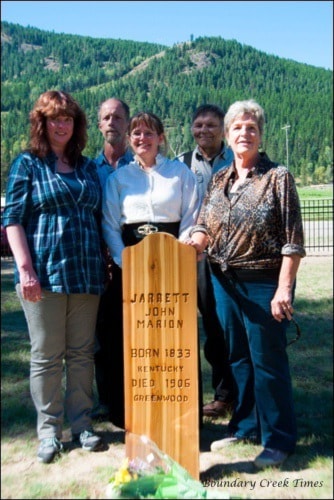A story of brotherhood, bloodshed and betrayal
By Jake Bianic - Special to the Times
Our print version of this story incorrectly stated that John Jarrett had owned property adjacent to the Bridesville Townsite. Greenwood Museum staff contacted us and offered the correction that Jarrett had pre-empted 320 acres in Rock Creek, and his residence was at William Meadows ranch, also in Rock Creek. We regret the error.
The path of an outlaw is never an easy one, but sometimes it’s the only one. John Jarrett, a man few may know today, was feared by many in the days of yesteryear.
Buried in the Greenwood Cemetery over 110 years ago, Jarrett’s gravesite was the scene of a service and marker dedication last Saturday.
Losing his father, his home and having his family displaced by men his father trusted, the Union side of the U.S. Civil War, left retribution in his heart. Jarrett fought in the Civil War with the Quantrills guerrillas and even saved his general, Joe Shelby from becoming a prisoner of war. After the war, he rode with the James-Younger Gang, robbing the men that robbed him, shooting down his enemies, and running from the law until he was reported to have died with his wife in a house fire in 1868.
This brought an end to a long and turbulent life for Mr. Jarrett… right? Well, this is where history tripped over the curb.
Enter Lorna Mitchell, a vibrant woman whose eyes open wide when you begin to mention history, and has just as much passion for the truth and the old west with its outlaws. She came across an interesting tidbit of information: a death certificate of a “John Jarrett” dated 1906. “Since I was a young kid I was interested in the James Younger Gang and I just wanted to learn the real story. Many thought he had died in 1868, but a genealogist in Missouri had found a death certificate that said he died in Greenwood in 1906, so I took that and ran with it.”
Her face was vibrant with excitement. “The whole historical community is excited about this, not just the James-Younger Gang, but the Quantrills Society, and they’ve gotten really stirred up.”
With a lot of work and just as much luck, Mitchell came into contact with a descendant of the Younger gang: Frank Younger. Unlike his outlaw ancestors, however, he is quite a pleasant man to deal with… he still rides a Harley though. Frank is part of the James-Younger Gang Association, a group of historians that follow the gangs’ history.
Frank and his wife Sharon began speaking back and forth with Mitchell, helping her with editing and facts, and becoming friends all the while. “I don’t know why she does it, she just shakes the subject like a dog shaking a bone!” Frank
joked. And with that, Mitchell began looking further into Jarrett’s relationship with Greenwood with the assistance of Greenwood Museum volunteer Wendy Higashi.
Instead of Jarrett “dying” in the house fire, it’s more than likely that it was a diversion.
While in the civil war, Jarrett made a trek inland to Victoria to pick up ships for the Confederacy, familiarizing himself with the Boundary on the way through. This is what more than likely initially introduced him to Canada. John must have liked what he saw in B.C., because after faking his death he made his way north with his two daughters. His daughters ended up settling in Victoria, marrying rich men and abandoning their father, while Jarrett settled in the Boundary area.
He pre-empted 320 acres in Rock Creek, and his residence was at William Meadows ranch, also in Rock Creek.He began to try his hand at an honest living and a fresh start, prospecting for minerals, and only ever speaking of his outlaw days to his closest inner circle.
He was serious about mineral mining too; he owned 10 claims, many in Greenwood and others in Rock Creek, but before he could really begin to make money at it, his health and age began to catch up to him.
He lay sick and dying in Greenwood. His daughters heard of this and came visiting, expecting a will and testament—when they found out there wasn’t one, they lost interest in their father altogether and left him to die alone, and to burial in an unmarked grave. That’s right; they couldn’t even bother to give their father the right to a proper burial.
But Mitchell, the James-Younger Gang Association, and staff of the Greenwood Museum changed that. Essentially re-writing history, they have now shone a new light on this man and his legacy.
Two very talented local men, Alan Wright and Regge Gosling, volunteered to carve the wooden grave marker that now marks Jarrett’s resting place in the Greenwood Cemetery. A proper military service and grave marker dedication took place Saturday.
But why have a service for a criminal who has had a less than clean past and a filthier record? Well, Gosling, not only a woodworker but a wordsmith as well, had the answer to that.
“We’ve all got family, even ourselves who may have a chequered background, but at some point they did contribute to the community… so we can’t condemn nor commend the things that took place in the past, only what he was able to do for the community here.”
The man may have been an outlaw, but his quest for redemption has finally ended in small town Greenwood, British Columbia.
